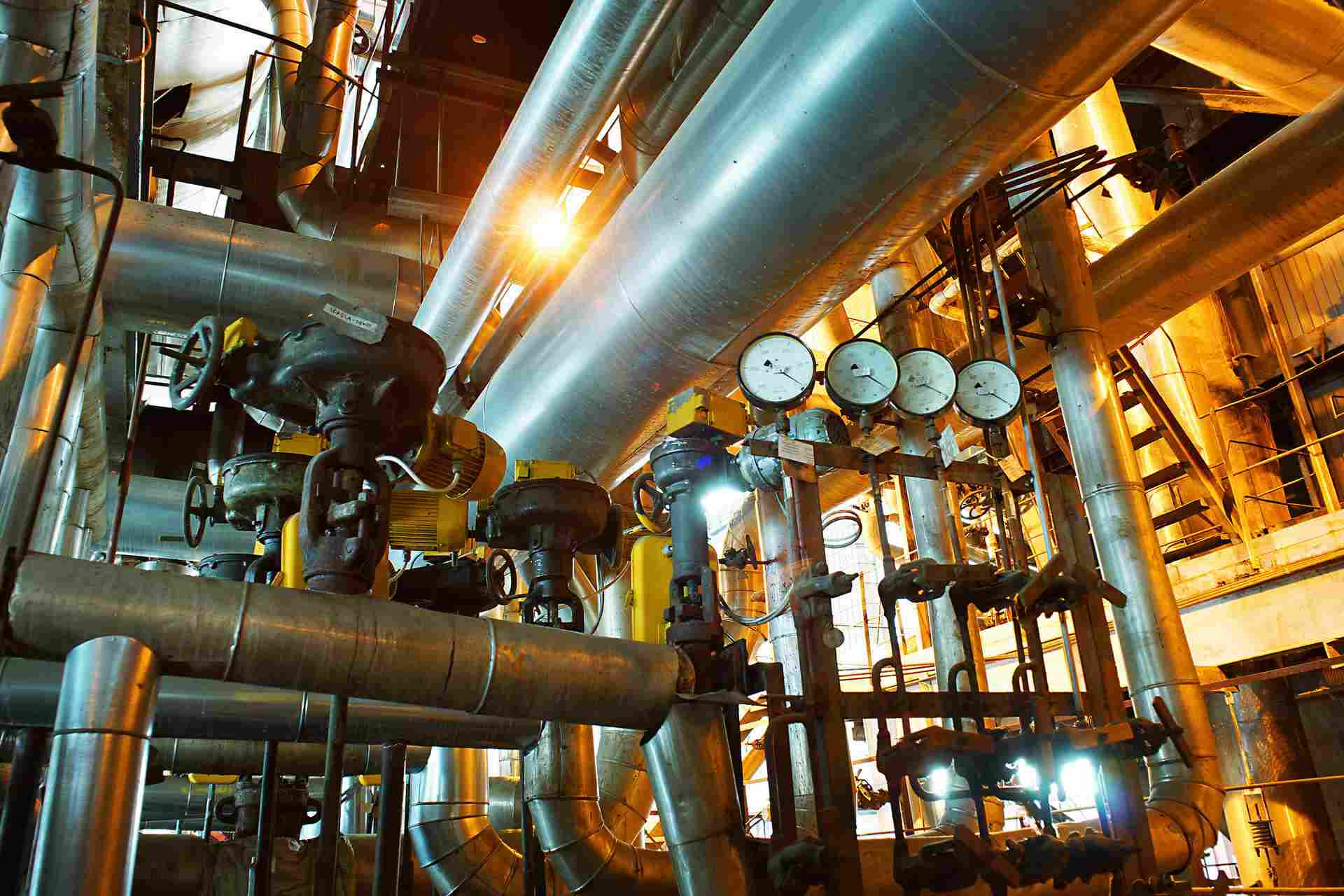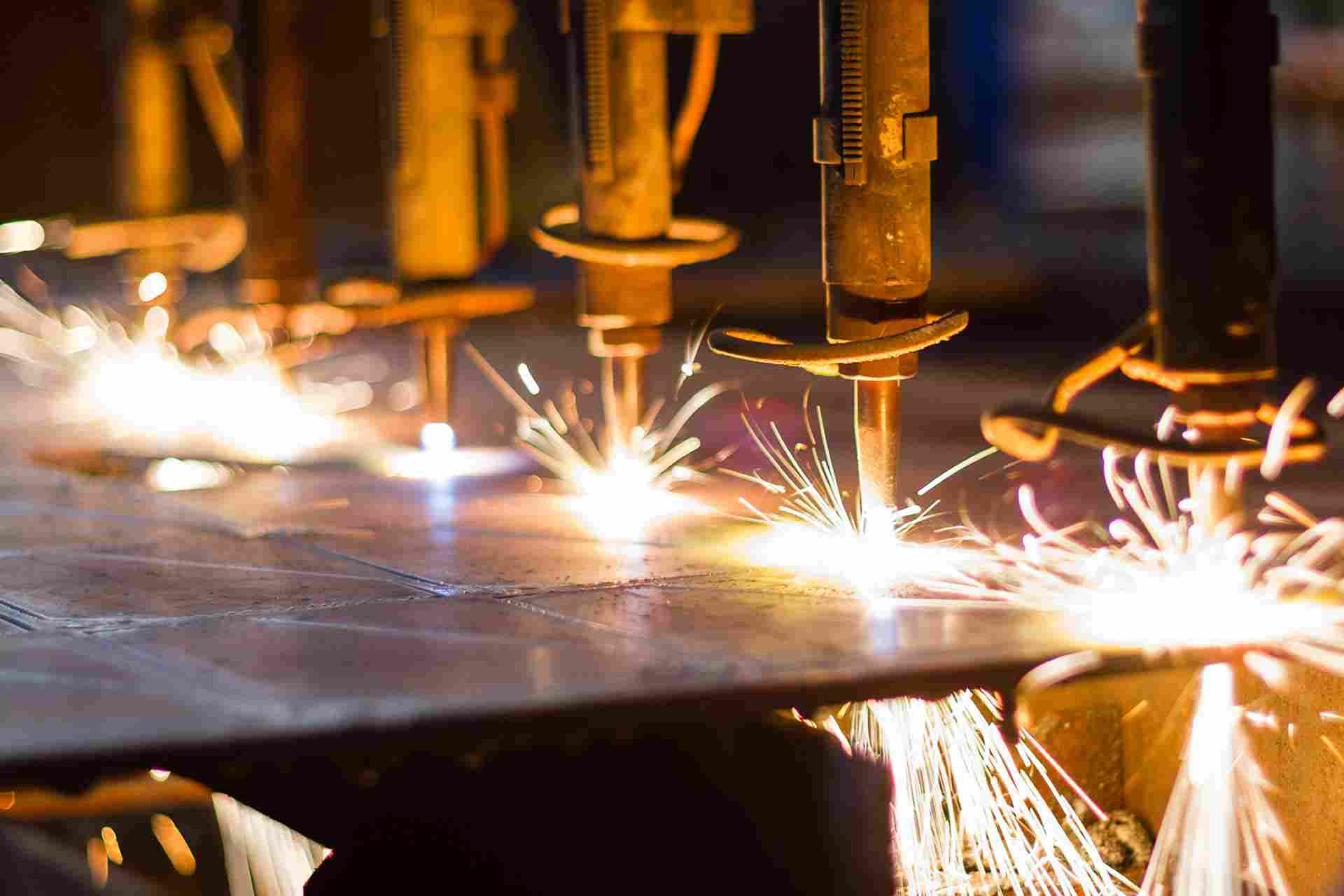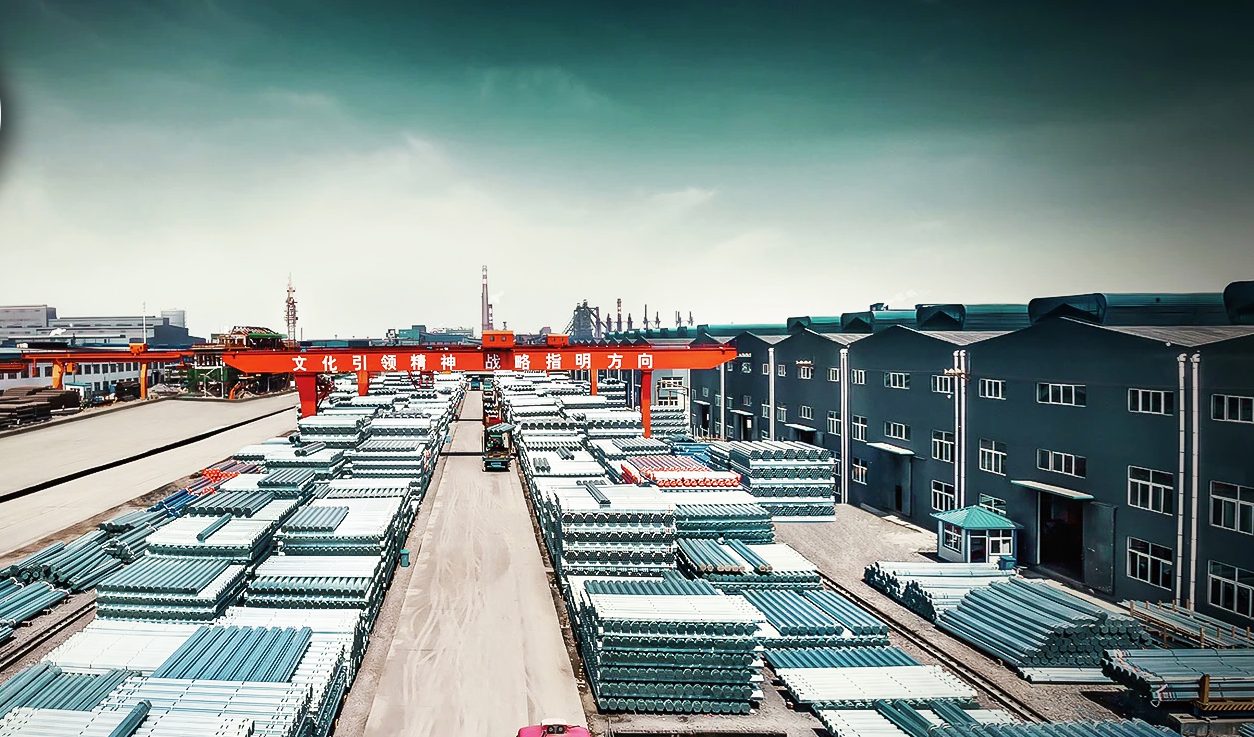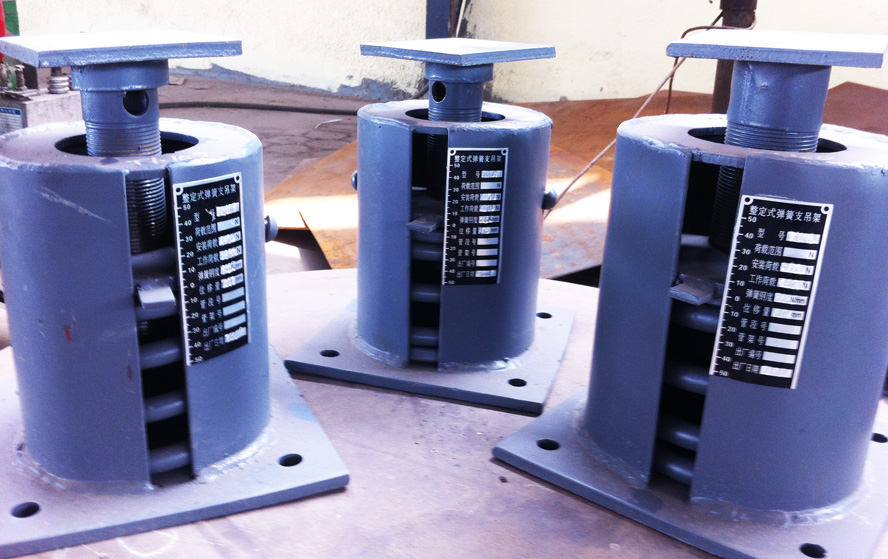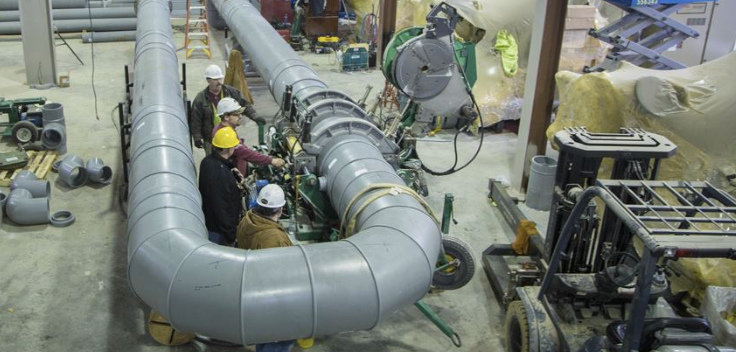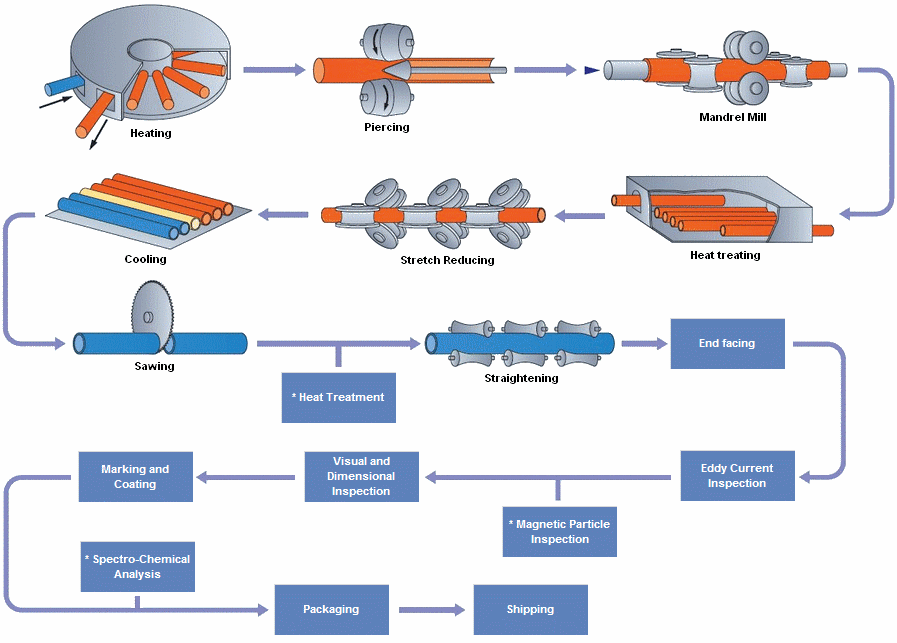
Çelik Boru ve İmalat Süreçleri
giriiş
Yuvarlanan değirmen teknolojisinin ortaya çıkışı ve on dokuzuncu yüzyılın ilk yarısında gelişimi de tüp ve boru endüstriyel üretiminde müjdelendi. İlk olarak, Huni düzenlemeleri veya rulolar ile dairesel bir kesit içine yuvarlanmış tabaka şeritleri oluşturuldu, Ve sonra popo veya tur aynı ısıda kaynaklanmış (Dövme Kaynak İşlemi).
Yüzyılın sonuna doğru, Dikişsiz tüp ve boru üretimi için çeşitli işlemler mevcuttu, üretim hacimleri nispeten kısa bir süre boyunca hızla artmaktadır. Diğer kaynak işlemlerinin uygulanmasına rağmen, Kesintisiz tekniklerin devam eden gelişimi ve daha da iyileştirilmesi, kaynaklı tüpün neredeyse tamamen piyasadan çıkmasına yol açtı, Sonuç olarak, İkinci Dünya Savaşı'na kadar kesintisiz tüp ve borunun hakim olduğu.
Sonraki dönemde, Kaynak teknolojisine ilişkin araştırmanın sonuçları, kaynaklı tüpün servetinde bir yükselişe yol açtı, Gelişen gelişme çalışmaları ve çok sayıda tüp kaynak işleminin geniş yayılması ile. Şu anda, Dünyadaki çelik tüp üretiminin yaklaşık üçte ikisi kaynak işlemleri ile açıklanmaktadır. Bu rakamın, Yine de, Yaklaşık dörtte biri, dikişsiz tüp ve boru üretiminde ekonomik olarak uygun olanların dışında boyut aralıkları halinde büyük çaplı hat borusu biçimini alır..
Çelik borular yapılırken? (Alman yorumu)

Alman yorumu parlak…Umarım konuşmacının ne dediğini ve gösterdiklerini anlarsınız (-:
Kesintisiz tüp ve boru
Ana kesintisiz tüp üretim süreçleri, on dokuzuncu yüzyılın sonuna doğru ortaya çıktı. Patent ve mülkiyet haklarının süresi dolduğu gibi, Başlangıçta takip edilen çeşitli paralel gelişmeler daha az belirgin hale geldi ve bireysel şekillendirme aşamaları yeni süreçlerle birleştirildi. Bugün, Son teknoloji ürünü, aşağıdaki modern yüksek performanslı süreçlere tercih verildiği noktaya kadar gelişmiştir.:
Sürekli mandrel haddeleme işlemi ve boyut aralığında itme tezgahı işlemi yaklaşık. 21 ile 178 mm dış çap.
Çok standartlı fiş fabrikası (MPM) kontrollü (kısıtlanmış) Yüzen mandrel çubuğu ve boyut aralığında fiş değirmeni işlemi yaklaşık. 140 ile 406 mm dış çap.
Boyut aralığında çapraz rulo piercing ve pilger haddeleme işlemi. 250 ile 660 mm dış çap.
Mandrel Değirmen Süreci

Mandrel değirmen sürecinde, sağlam bir tur (kütük) kullanılır. Bir döner ocak ısıtma fırında ısıtılır ve daha sonra bir delici tarafından delinir. Delmiş kütük veya içi boş kabuk, dış çapı ve duvar kalınlığını azaltmak için bir mandrel değirmeni ile yuvarlanır.. Ana tüp yeniden ısıtılır ve streç azaltıcı tarafından belirtilen boyutlara indirgenir. Tüp daha sonra soğutulur, kesmek, sevkiyattan dolayı bitirme ve denetim süreçlerine tabi tutuldu.

* Not: Yıldız işareti ile işaretlenen süreçler, spesifikasyon ve/veya müşteri gereksinimleri yürütülür
Mannesmann fiş değirmeni işlemi

Fiş değirmeni işlemi, sağlam bir tur (kütük) kullanılır. Döner ocak ısıtma fırında eşit olarak ısıtılır ve daha sonra bir Mannesmann Piercer tarafından delinir. Delmiş kütük veya içi boş kabuk dış çapta ve duvar kalınlığında yuvarlanır. Haddelenmiş tüp aynı anda bir makine ile içte ve dışarıda karıştırılmış. Ganenerli tüp daha sonra belirtilen boyutlara bir boyutlandırma değirmeni ile boyutlandırılır. Bu adımdan tüp düzleştiriciden geçer. Bu işlem tüpün sıcak çalışmasını tamamlar. Tüp (Ana tüp olarak adlandırılır) Bitirdikten ve muayeneden sonra, bitmiş bir ürün haline gelir.

Kaynaklı tüp ve boru
Şerit ve plaka üretmek mümkün hale geldiğinden beri, İnsanlar sürekli olarak tüp ve boru üretmek için malzemeyi bükmeye ve kenarlarını bağlamaya çalıştılar.. Bu, en eski kaynak işleminin geliştirilmesine yol açtı, Forge-Welding, geri dönüyor 150 yıllar.
İçinde 1825, İngiliz Ironware Tüccarı James Whitehouse'a kaynaklı boru üretimi için bir patent verildi. İşlem, açık ekranlı bir boru üretmek için bir mandrel üzerinde tek tek metal plakaları dövmekten oluşuyordu, ve sonra açık dikişin çiftleşme kenarlarını ısıtmak ve bir çekme tezgahında mekanik olarak bir araya getirerek onları kaynaklamak.
Teknoloji, bir kaynak fırında bir geçişte şeridin oluşabileceği ve kaynaklanabileceği noktaya kadar gelişti.. Bu popo kavramının gelişimi 1931 J tarafından tasarlanan fretz-moon sürecinde. Ay, bir Amerikalı, ve onun Alman meslektaşı fretz.
Bu işlemi kullanan kaynak hatları bugün hala tüp üretiminde yaklaşık dış çaplara kadar başarılı bir şekilde çalışıyor.. 114 mm. Bu sıcak basınç kaynak tekniğinin yanı sıra, şeridin bir fırında kaynak sıcaklığına ısıtıldığı, Amerikan E tarafından birkaç süreç daha tasarlandı. Yıllar arasında Thomson 1886 Ve 1890 Metallerin elektriksel olarak kaynaklanmasını sağlayan. Bunun temeli James P tarafından keşfedilen mülktü. Bir elektrik akımının bir iletkenden geçirilmesi, elektrik direnci nedeniyle ısınmasına neden olur.
İçinde 1898, Standart Araç Şirketi, Amerika, Tüp ve boru üretimi için elektrik direnç kaynağı uygulanmasını kapsayan bir patent verildi. Elektrik Direnç Kaynaklı Tüp ve Boru Üretimi Amerika Birleşik Devletleri'nde önemli bir destek aldı, Ve çok daha sonra Almanya, Büyük ölçekli üretim için gerekli olan toplu başlangıç malzemesinin üretimi için sürekli sıcak şerit haddeleme değirmenlerinin kurulmasını takiben. İkinci Dünya Savaşı sırasında, Argon ark kaynağı işlemi icat edildi – Yine Amerika Birleşik Devletleri'nde – uçak yapımında magnezyumun verimli kaynağını sağlayan.
Bu gelişmenin bir sonucu olarak, Çeşitli gaz korumalı kaynak işlemleri geliştirildi, ağırlıklı olarak paslanmaz çelik tüp üretimi için. Sonunda enerji sektöründe meydana gelen geniş kapsamlı gelişmeleri takip etmek 30 yıllar, ve sonuçta büyük kapasiteli uzun mesafeli boru hatlarının yapımı, Subkerged-Arc kaynak işlemi, çaplardaki hat borusunun kaynağı için yaklaşık bir ön planlama pozisyonu kazanmıştır.. 500 mm.
Elektrikli Kaynak Fabrikası
Bobin içinde çelik şerit, geniş şeritten gerekli genişliğe kesilen, çok uzunluğunda bir kabukta bir dizi şekillendirme rulosu ile şekillendirilir. Boyuna kenarlara sürekli olarak yüksek frekanslı direnç/indüksiyon kaynağı ile birleştirilir.
Birden fazla uzunluklu kabuğun kaynağı, daha sonra elektriksel olarak kafa ile işlenir, Uçan bir kesme makinesi ile belirtilen uzunluklara boyutlandırılmış ve kesilmiş. Kesilen boru her iki uçta düzleştirilir ve kare edilir.
Bu işlemleri ultrasonik muayene veya hidrostatik testler izler.


